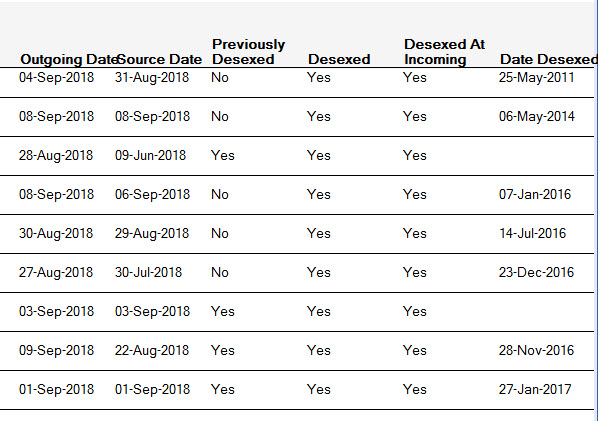NOTE: the reports in question use the term "desexed" on the report form, but the report result will display whatever your site is set to show (e.g. Spayed/Neutered). For the purposes of this document, we will use the term "desexed" for consistency.
This term equates to "Altered" or "Spayed/Neutered".
Tracking the numbers of animals that were desexed prior to entering care can be difficult for incoming animals because you don't always determine at the time of intake that the pet was previously desexed.
Your user's consistency and methods of recording the information will also come into play.
It can also depend on what exactly you consider "previously desexed" to be - some sites consider this to be any pet that was desexed prior to intake, regardless of how or where that took place, while others are looking only for pets that were desexed outside of their organisation and prefer to exclude pets that they performed the surgery on - even if it took place years ago, well prior to the intake relevant to the target dates. This is something you must determine for yourself.
To find the numbers of previously altered pets, we recommend this approach:
If you would like to focus on intake only, use 197 Incoming Detail List.
- make sure the option "Prev. desexName" is marked to show on the report return. (relies entirely on your staff remembering to mark this field reliably).
- This will indicate all the pets that came into care during the target period that were flagged as Previously Desexed.
- When the report has been run, export the result to excel and sort by this column to find your totals.
If you would like to examine the accuracy of your users' consistency with this field, use 198 Outgoing Detail List and mark the following options to show on the report return:
- Date desexed
- desexed
- desexed at Incoming
- Previously desexed
- Source Date
Once this report is run, you can do the same as before - export to excel and sort by the previously desexed column - but you can now use the other two columns relating to spay/neuter information to see whether or not the pet has a spay/neuter date.
If the pet was spayed/neutered in-house, there will always be a date in the Date Desexed column that occurs after the Source date.
If the pet was previously spayed/neutered, it should have "Yes" in the columns that are headed Previously Desexed, Desexed, and Desexed at Incoming.
However, you may find that every now and then, one of your staff may miss the Previously Desexed marker, and the Desexed at Incoming, in this case, might also be blank or show Unknown, rather than showing "Yes" (which indicates this status was assigned immediately at intake).
The relevant section of the report will look something like this:

From this example: because the Source Dates from the sample are all from the year 2018, but all of the dates in the Date Desexed column are from prior to that year, we can tell that ALL these pets were previously desexed, even though the Previously Desexed column only shows Yes in 4 out of 9 cases.
However, if your site prefers to exclude pets that were desexed at their own clinics - even if it took place long before this intake - then only 2 pets here are relevant: those with no dates in the Date Desexed column.
If Previously Desexed is No, Desexed at Incoming is also No, but Desexed is Yes and there is no date in the Date Desexed column, there is a high likelihood that this pet was altered prior to intake but the Previously Desexed field wasn't marked.

Comments